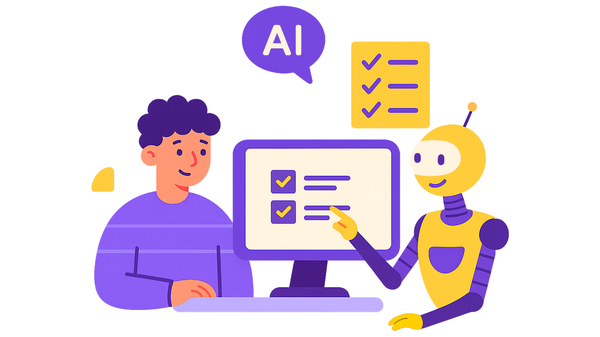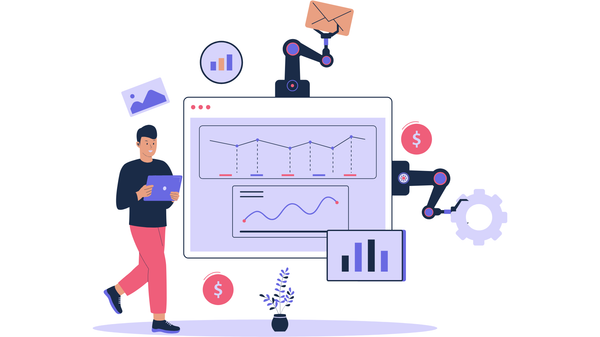7 Simple Hiring Workflows You Can Automate in One Afternoon
Save hours every week with recruitment automation. Here are 7 simple hiring workflows you can automate in one afternoon without technical skills.

Recruitment is full of small but repetitive tasks — updating spreadsheets, sending emails, booking interviews, and following up with candidates. For small businesses and HR teams, these jobs can consume entire days.
The irony is that most of these actions follow the same predictable pattern every time you hire. That makes them perfect for automation.
You do not need complex software or technical expertise to do it. With the right setup, you can build an efficient hiring system that runs quietly in the background, giving you more time to focus on candidates rather than admin.
In this guide, you will learn seven hiring workflows you can automate today — using simple, affordable tools that take just an afternoon to set up.
What Is a Hiring Workflow?
A hiring workflow is a series of steps that take a candidate from application to offer. Every process in your recruitment pipeline — job posting, screening, interviewing, and onboarding — is a workflow.
Automation connects these steps, so once one action is completed, the next begins automatically.
For example:
- A candidate applies through a form.
- The data goes into a spreadsheet.
- An email confirmation is sent instantly.
- The candidate is moved to a shortlist tab if they meet criteria.
That simple chain eliminates several manual steps while maintaining control and visibility.
Why Automate Hiring Workflows?
Recruitment automation benefits go beyond convenience. It improves consistency, fairness, and the overall candidate experience.
Key benefits:
- Saves time by removing repetitive work
- Reduces manual errors
- Speeds up response times
- Provides a consistent candidate experience
- Frees recruiters to focus on interviews and strategy
For small businesses, automation creates the feeling of having an extra team member — without increasing payroll.
What You Need Before You Start
Before building automated workflows, prepare these basics:
- Clear job description templates (Google Docs or Notion)
- An application form (Google Forms, Typeform, or Jotform)
- A spreadsheet or database (Google Sheets, Excel, or Airtable)
- Calendar access (Google Calendar or Outlook)
- An automation connector (Zapier, Make, or HubSpot)
Once you have these elements in place, you can link them together to create seamless processes.
Workflow 1: Automated Job Posting Across Multiple Platforms
Posting your job adverts one by one wastes valuable time. Automate distribution so that when you create a new listing, it publishes everywhere at once.
How to do it:
- Write your job ad in Google Docs.
- Connect Google Docs to Make or Buffer.
- Create a trigger: when a document is added to a “Job Ads” folder, it automatically posts to LinkedIn, Facebook, or Twitter.
This simple workflow ensures that your jobs reach a wide audience instantly without repetitive uploading.
Extra tip: For consistent messaging and tone, collaborate with a recruitment automation agency that can help align your adverts with your employer brand.
Workflow 2: Automatic Application Collection
Instead of managing email submissions, create a form that feeds applications directly into a spreadsheet or database.
How to do it:
- Build a Google Form with basic fields such as name, contact, and CV upload link.
- Link it to Google Sheets automatically.
- Each response creates a new row with timestamped data.
You can even set up automatic confirmation emails thanking candidates for applying.
This saves hours of manual tracking and guarantees that no application slips through the cracks.
Workflow 3: Automatic Candidate Screening
Manual screening is slow and subjective. Automate early-stage filtering to identify qualified candidates quickly.
How to do it:
- Use a spreadsheet formula or filter to flag candidates meeting minimum criteria.
- Integrate simple keyword filters using tools like Zapier or ChatGPT prompts.
- Move qualifying candidates automatically into a “Shortlist” tab.
This system reviews applications instantly and gives you a shortlist ready for review.
For detailed guidance, see automating Candidate Screening.
Important: Automation saves time, but fairness matters. For advice on keeping screening ethical and inclusive, read avoid bias when automating resume screening.
Workflow 4: Automated Interview Scheduling
Scheduling interviews manually is one of the biggest time drains in recruitment. Automation can eliminate the back-and-forth completely.
How to do it:
- Use Calendly, Google Calendar Appointment Schedules, or Microsoft Bookings.
- Sync your availability automatically.
- Send candidates a booking link as soon as they reach the interview stage.
The system handles confirmations, reminders, and reschedules automatically.
Learn how to set this up in detail with how to automate interview scheduling.
Workflow 5: Automated Candidate Communication
Keeping candidates updated throughout the process is essential for your employer brand — but doing it manually is exhausting. Automation ensures no one is left waiting.
How to do it:
- Create message templates for each stage: application received, interview invite, rejection, or offer.
- Use Gmail templates or an email marketing tool such as Mailchimp or HubSpot.
- Set up triggers in Zapier so that when a candidate’s stage changes, the right message is sent automatically.
This provides consistency and professionalism at scale.
For guidance on crafting kind, clear messages, read and write a polite rejection email with a positive tone.
Workflow 6: Automated Offer and Onboarding
The hiring process does not end with the offer. Automating onboarding ensures that every new hire has a smooth, welcoming experience.
How to do it:
- Use Google Docs or ClickUp templates for offer letters.
- Send documents for digital signature using DocuSign or Adobe Sign.
- Trigger onboarding tasks in project management tools like Asana or Trello.
Each new hire receives contracts, welcome materials, and access instructions automatically.
For small businesses, you can build these systems easily without an ATS. See the Small Business Guide to Automating Hiring Without an ATS.
Workflow 7: Automated Reporting and Analytics
Data is the foundation of continuous improvement. Automated reporting gives you instant insights into recruitment performance.
How to do it:
- Connect your spreadsheet to Google Data Studio or Power BI.
- Automate updates to show live metrics such as time-to-hire, source of hire, and candidate conversion rates.
- Create weekly or monthly dashboards to track performance automatically.
For essential metrics, read 5 Recruitment KPIs Every SME Should Monitor Monthly.
Putting It All Together: One Connected System
When you link these seven workflows together, you create a recruitment engine that runs continuously and efficiently.
Here is what that looks like in practice:
- Job ad created → automatically shared across platforms.
- Applications submitted → stored in a central spreadsheet.
- Candidates screened → shortlist generated automatically.
- Shortlisted candidates → receive scheduling links instantly.
- Messages → triggered automatically for every stage.
- Offers and onboarding → handled with digital templates.
- Reports → updated live for real-time insights.
In less than one afternoon, you can have a fully operational hiring system that works without micromanagement.
To see how small changes can save major time, read Using Automation to Save Time in SME Recruitment.
Avoiding Common Automation Pitfalls
Automation works best when implemented thoughtfully. Avoid these common mistakes:
1. Automating Bad Processes
If your process is inefficient, automation will only make it faster — not better. Simplify before you automate.
2. Overlooking Human Oversight
Automation cannot evaluate culture fit or potential. Always keep human review at key decision points.
3. Ignoring Compliance
Ensure you comply with UK GDPR when handling candidate data and automated messages.
For details on ethical automation, read can ChatGPT legally be used to make hiring decisions?.
4. Poor Communication Tone
Automation should never feel robotic. Review your templates regularly to ensure they reflect your brand and empathy.
The Payoff: What You Gain by Automating These 7 Workflows
When done well, these simple automations deliver measurable impact:
- 80 per cent reduction in admin time
- Faster time-to-hire
- More consistent communication
- Higher candidate satisfaction
- Improved data accuracy and visibility
These improvements directly translate to better hiring outcomes and a stronger employer brand.
If you are unsure where to start, consult a recruitment automation agency to design a plan suited to your team’s size and goals.
Real Example: Automating an Entire Hiring Cycle
A small tech consultancy used free tools like Google Forms, Make, and Calendly to automate their entire recruitment process.
Before automation:
- Each role required 20 hours of manual admin.
- Average time-to-hire: 21 days.
- Many candidates stopped responding mid-process.
After automation:
- Admin time dropped to 4 hours per role.
- Time-to-hire fell to 7 days.
- Candidate feedback scores improved by 45 per cent.
Automation did not just save time — it completely transformed their candidate experience.
Measuring the Results of Your Automation
Track performance from the start to prove ROI:
- Time saved per week
- Number of candidates processed automatically
- Candidate satisfaction feedback
- Hiring cost per role
These metrics will show the clear benefits of automation within weeks.
Scaling Beyond the First Seven Workflows
Once you have automated the fundamentals, you can expand your system to handle advanced functions such as:
- AI-powered candidate sourcing
- Predictive analytics for hiring success
- Chatbots that answer candidate questions instantly
To learn how to create a self-running recruitment engine, see how to Build a 24/7 Recruiting Assistant That Works While You Sleep.
Automation is not about replacing recruiters — it is about removing repetitive tasks that slow them down.
By automating these seven workflows, you will save hours each week, deliver faster responses, and provide a better candidate experience without increasing workload or cost.
Start small. Build one workflow today. Within a few weeks, you will have a recruitment system that feels effortless, efficient, and modern.
If you would like expert guidance to design the right automations for your business, book a call with our team. We will help you set up tools that simplify hiring.




